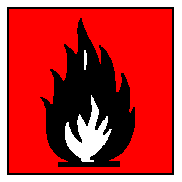International Chemical Safety Cards
| METHYL ISOCYANATE | ICSC: 0004 |
| METHYL ISOCYANATE Isocyanatomethane Isocyanic acid, methyl ester MIC CH3NCO Molecular mass: 57.1 CAS # 624-83-9 RTECS # NQ9450000 ICSC # 0004 UN # 2480 EC # 615-001-00-7 |
 |
 |
| TYPES OF HAZARD/ EXPOSURE |
ACUTE HAZARDS/ SYMPTOMS |
PREVENTION | FIRST AID/ FIRE FIGHTING |
| FIRE | Highly flammable. Many
reactions may cause fire or explosion. Gives off irritating or toxic fumes (or gases) in a
fire. |
NO open flames, NO sparks,
and NO smoking. NO contact with water, acid(s), base(s), amines, alcohols, oxidizing
agents. |
Alcohol-resistant foam, dry
sand, powder, carbon dioxide. NO hydrous agents. |
| EXPLOSION | Vapour/air mixtures are
explosive. Risk of fire and explosion when heated or in contact with water or catalysts. |
Closed system, ventilation,
explosion-proof electrical equipment and lighting. Do NOT use compressed air for filling,
discharging, or handling. |
In case of fire: cool
drums, etc., by spraying with water but avoid contact of the substance with water. Combat
fire from a sheltered position. |
| EXPOSURE | |
PREVENT GENERATION OF
MISTS! AVOID ALL CONTACT! |
IN ALL CASES CONSULT A
DOCTOR! |
| INHALATION | Corrosive. Cough.
Dizziness. Laboured breathing. Shortness of breath. Sore throat. Unconsciousness.
Vomiting. |
Local exhaust or breathing
protection. |
Fresh air, rest.
Half-upright position. Artificial respiration if indicated. Refer for medical attention. |
| SKIN | Corrosive. MAY BE ABSORBED!
Skin burns. Pain. |
Protective gloves.
Protective clothing. |
Remove contaminated
clothes. Rinse skin with plenty of water or shower. Refer for medical attention. |
| EYES | Corrosive. Pain. Loss of
vision. Severe deep burns. |
Face shield or eye
protection in combination with breathing protection. |
First rinse with plenty of
water for several minutes (remove contact lenses if easily possible), then take to a
doctor. |
| INGESTION | Corrosive. Abdominal
cramps. Sore throat. Vomiting. |
Do not eat, drink, or smoke
during work. |
Rinse mouth. Do NOT induce
vomiting. Give plenty of water to drink. Refer for medical attention. |
| SPILLAGE DISPOSAL | STORAGE | PACKAGING & LABELLING | ||
| Evacuate danger area!
Consult an expert! Ventilation. Collect leaking liquid in sealable containers. Absorb
remaining liquid in dry sand or inert absorbent and remove to safe place. Do NOT wash away
into sewer (extra personal protection: complete protective clothing including
self-contained breathing apparatus). |
Fireproof. Separated from
all other substances. Cool. Dry. |
Special material. F symbol T symbol R: 12-23/24/25-36/37/38 S: 9-30-43-44 UN Hazard Class: 6.1 UN Subsidiary Risks: 3 UN Packing Group: I |
||
| SEE IMPORTANT INFORMATION ON BACK | ||||
|
||||